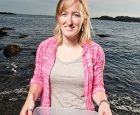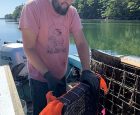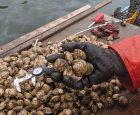
Maine explores potential for farming higher-value clam
March 18, 2020
By
Liza Mayer
Growing clams as auxiliary crop in oyster farms could spawn new industry

Seafood farmers in Maine are exploring the commercial viability of farming quahogs or hard clams in bags placed under floating oyster farms as a supplementary crop.
The technique known as multi-trophic aquaculture will not only address the dwindling harvest of quahogs from the wild caused by Maine’s warming waters, but also protect them from predators and boost farmers’ shellfish harvests without increasing the farm’s footprint.
The method is a departure from the traditional way of farming clams where growers bury clam seeds into the mud and then cover the flats with nets to protect them from predators, particularly green crabs and diving ducks.
Local farmer Jordan Kramer of Winnegance Oyster Farm in New Meadows River, Maine says routinely finding wild quahogs attached to his oyster gear when he hauls them up after winter persuaded him to try farming them.
“Having them in contained culture in the mud below the farm seemed possible because they were growing so well,” he says. In 2017, he started experimenting initially with 20,000 quahogs split among several bags and planted them under two-tiered oyster cages suspended from lines. Those quahogs reached the market in the fall of 2019.
“There’s something like 200,000 in the water now of various sizes. In the coming years, I think a very small farm like my own (1,600 square feet of lease) can have as many as 30,000 clams coming out each year,” he says.
Inspired by Kramer’s success in growing quahogs this way, nonprofit organization Manomet has launched an initiative to explore quahog’s potential as a farmed crop. The organization helps develop scientifically grounded, environmentally sustainable ventures. It has received a $65,000 grant from the National Oceanic and Atmospheric Administration’s Sea Grant program for the project.
Quahog (Mercenaria mercenaria) aquaculture is an established industry in neighboring Massachusetts but it is only at experimental stage in Maine because local water temperatures were historically too cold for quahog aquaculture.
“The Gulf of Maine is warming incredibly rapidly. The water temperature is becoming much more suitable for farming quahog in Maine,” says Dr Marissa McMahan, marine fisheries division director at Manomet.
Low-maintenance
Although a farmer could wait for more than two years before quahogs reach market size, they are much easier to maintain than oysters although Kramer warns one can’t just plant the quahog seeds in bags 20 feet below the water surface and fully forget about them.
Kramer is speaking from experience. He has lost hundreds of crops, not to predators, but by losing bags when they get buried too deeply in the mud because of drifting debris. “They could still sink too deep in the mud, but pulling them out of the mud once a week or once a month is not a lot of work. It’s tugging on a rope as opposed to air-drying and hand-washing them like one does with oysters. It’s really a low-maintenance way to farm.”
Higher-value clam
Not only do farmed quahogs require lower maintenance, they also enjoy a niche market locally. Maine prohibits the harvest of wild quahogs that are less than one inch in thickness; that restriction does not apply to farmed quahogs. “One can sell farmed quahogs below that size. Smaller quahogs are actually very appealing to the raw half-shell market,” says McMahan.
Kramer is able to sell farmed quahogs for 40 cents apiece at wholesale, whereas wild quahogs are typically sold for 25 cents apiece. By comparison, soft shell clams are sold by the bushel (roughly 50 lbs) from $60 to over $100 depending on the season. Oysters, Maine’s top farmed shellfish produce, fetch $0.75 to over $1 apiece.
He says a standalone farm of just quahogs might not be as financially viable than if it were just an auxiliary crop. But that’s one of the things the Manomet project will determine.
“We’re expanding Jordan’s work to three other farmers to see if his method is replicable in other farms and whether it is economically viable,” says McMahan.
Four farmers, including Kramer, will feed data from their farms to Manomet. “We want to measure growth and environmental variables and from there make recommendations about best practices and give potential farmers a sense of what they’re looking at in terms of investments,” said McMahan.
She hopes this initiative will also help address the biggest challenge Kramer saw as a quahog farmer.
She explains: “One of the real hurdles that we’re working through is the nursery phase, which is how to keep seed that is one millimeter in size in a containment method where you don’t lose it but there’s also water flow going through so that they don’t die. So that is the single biggest challenge right now.”
The quahog farmers in the project are using the same type of mesh that oyster growers use. “It’s been it’s been tricky working with seed so small (1 mm),” says Kramer. “They seem to find their way out of the mesh a little bit easier than baby oysters because they’re just so round so they shift a little bit more.”
“We’ve had our hiccups in terms of getting things going in terms of growth and figuring out exactly how to get them to market without too many losses. But really the overhead for it is very inexpensive. I think we’ll see a lot more people experimenting with this technique and tinkering with it to improve it because it really is something you can try without a lot of risk,” he says.
Manomet expects the results of the project to become available in the summer of 2021.
Advertisement
- Project seen transformative for hard clam industry in US east coast
- B.C. salmon farmers’ group ceases farm visits amid Covid-19








